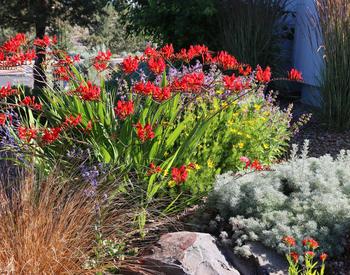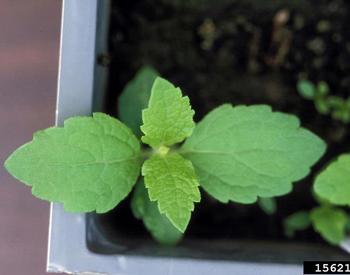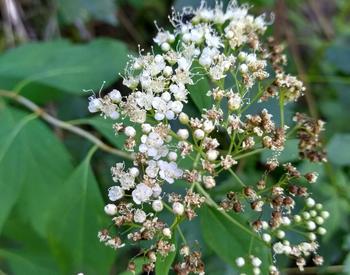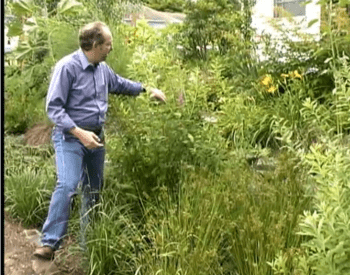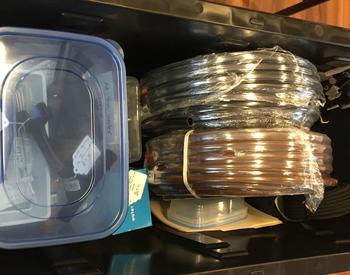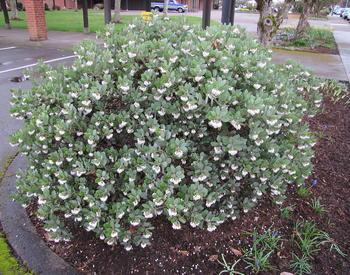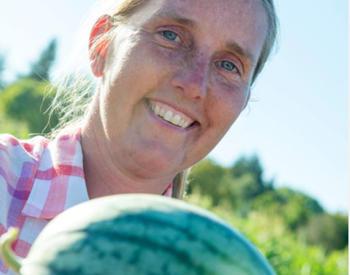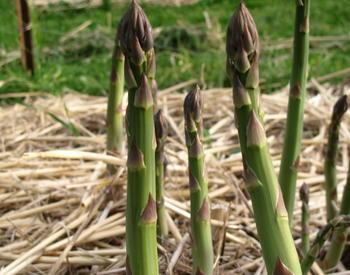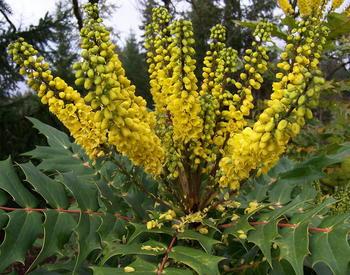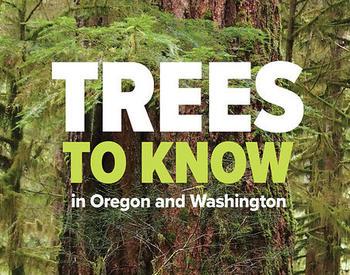Transcript
Speaker 1
From the Oregon State University Extension Service, this is pollination, a podcast that tells the stories of researchers, land managers and concerned citizens making bold strides to improve the health of pollinators. I'm your host. Doctor Adoni Melitopol, his assistant professor in pollinator health in the Department of Horticulture. It's August in Oregon. It's hot, it's dry. But if you look closely, the pollinators are still coming to your garden. But maintaining that pollinator biodiversity and staying water wise is a tricky business. So I thought this was a good opportunity to talk to somebody who has experience with these gardens in some place hotter and drier than here. So I reached. Out to Doctor Rosalind Johnson, who runs a biodiverse garden consulting company called Yard bio.com in the San Francisco Peninsula. Area we met at the regional BIA delicious conference in the spring where we heard about all sorts of challenges about creating biodiversity in the cities around pollinators, especially in an area that's experiencing rapid urbanization and also these fires and these hotter, drier summers. This episode is for you. If you're looking out at your garden thinking, how can you create biodiversity in the city in the hot, dry month of? August. Hope you enjoy the episode. All right. I am really pleased to welcome Doctor Johnson to pollination.
Speaker 2
Hi Anthony. It's so nice to be here. This is Roslyn Johnson. You can just call me Roz.
Speaker 1
There's this growing movement towards biodiversity increasing biodiversity in in cities and we had on a previous episode Lincoln Best, who was talking about, at least in the city of Calgary, how they've set targets for increasing bias. City and I just want to begin by explaining why building biodiversity in cities is so important?
Speaker 2
That's a really interesting question and I'm going to try and answer it. I don't know if I can, if I can encompass the entire thought, but I'll give you what I've been thinking about it. I think that the preservation and parks movement in cities is well established, and that's complemented by people. Gardening and their ability to develop a small habitat for themselves around their homes. Kind of parcel by parcel they are. In a position to make a difference in the world from where they are. And their politics. Probably lead them to think more in terms of preservation of. Natural resources than just conservation, so it's not just about hunting in cities, it's also about. Biodiversity and the whole preservation thing. And so, what I'm finding in San Francisco is that everybody's got their little parcel. And what I'm trying to do is. Convince them to take a part of their parcel and make it available to these. And wildlife.
Speaker 1
It seems like a situation that you know also applies here to Oregon. It seems like the San Francisco Peninsula area is experiencing extreme growth and that it's coming up against areas that may have been natural. So, can you, can you briefly lay out the issue specific to the sand San Francisco Peninsula area when it comes to urban? Diversity, like what? Tell us a little bit more on the ground. Some of the kind of key issues that people are contending.
Speaker 2
As you know, one of the key issues is availability is. Plants. If you're doing any kind of pollinator gardening or for that matter, any kind of wildlife gardening, you're gardening for pollinators, for birds, for small mammals, just the whole. Mix of animals that can occur and tolerate people in an urban environment. So, we've. Everything from Ravens and sparrows and blackbirds to pocket Gophers, many different kinds of bees and butterflies.
Speaker 1
I remember when I was down at the beauticians' conference with you, I was really surprised that there was, at the same time, a shortage of native plants. There seems to be, at least in the San Francisco Peninsula area, also some great efforts to increase the availability. Can you? Talk a little bit about them.
Speaker 2
Absolutely. One of my one of the main hats for where this is a big economy after all, and even ecologists have to do different goods. One of my gigs is that I'm on the Board of Directors for San Bruno Mountain Watch, which is a local environmental group. That looks after the interests of San Bruno Mountain, and that is huge. UM. Natural area just South of the city. In fact, if you've flown into the San Francisco Airport. When you're coming up into the city, there's a huge mountain range on the left. And that San Bruno Mountain. And it is still a natural area. It's managed by the county of San Mateo. And it has. The remnant population, is one of the most important remnant populations. Natural land that's left on the San Francisco Peninsula. So, it is the source. Or native plants for this region. One of the sources, I mean you can get your plants from across the Bay over at Annie's annuals, which is great, but if you go to the mission blue nursery which is managed by San Bruno Mountain watch, then you're getting plants that are actually. Sourced on the mountain itself. And they propagate them for restoration activities on the mountains. But the extra plants are used to sell the people for their gardens. To raise money for further restoration efforts.
Speaker 1
Oh, what a great connection.
Speaker 2
Yeah, and. And so, I've been working with them and volunteering at the nursery. So that I can learn all of the plants there are different growth stages and how to take care of them. So that I can install them in people's yards and make them grow there.
Speaker 1
You've got this experience working in an extent remnant of native plants, and we were talking about gigs earlier and I just wanted to ask you as well, one of the key things of the reasons for inviting you on here is that you've got this experience advising homeowners on how to incorporate biodiversity into their urban spaces. Can you tell us how you managed to tackle this issue? Bringing biodiversity into the city at the level of different property owners because I imagine people have a lot of different demands, they have a lot of expectations.
Speaker 2
Well, it's been it's been a really interesting ride so far with Yard Bar. I've been doing this for two years. People have been. Open to the idea, but I have to be very clear with them about that. I'm an ecologist. And the garden. But I'm not a gardener like, you know, the gardener that you hire for $20. I'm not a landscaper, either. I don't put in irrigation. And I don't put big infrastructure into a yard. What I'm trying to do is very focused on yard bile. I'm trying to increase pollinator and wildlife habitat in people's yards, not necessarily by changing the entire design. But by working with the existing infrastructure, the existing landscaping, and finding those pockets where I can put in some native plants. That will help too. Diversify the plant community of the yard and provide. Pollen and nectar for pollinators to use, so part of my biggest challenge so far has been trying something new that I have to define. To people. Rather than going in and saying you know him this is yardbuyer.com and I'm a landscaper, then they know what to expect. If I go in and say you're buy.com and. I'm an ecologist. And I want to help you diversify your backyard. You know, they're like, oh, well, I didn't know I needed that. Andosol so I tell them basically that if they want to help these, they don't have to wait. They don't have to wait for the government. Sure, they don't have to wait for anybody else. They can help the populations that are already in the urban area survive better and propagate themselves just by planting native plants in their yards. It's made me much better at describing what it is that I can and. Cannot do for them.
Speaker 1
So, if I can just interrupt you for a second, you've got. So, you have, you know, I was thinking about expectations and but here you're in a, you have a nice situation because you're taking somebody's you know. An urban space? They're already living in uncomfortable and in some sense, it's kind of like a tweak. It's like thinking ecologically, thinking about, you know, different pollinator plants, different pollinators and thinking, OK, you need this, this and this. And this would fit in here and would look good. And it's kind of. Rather than a drastic like, I'm going to take your backyard and scrape it. We're going to start from scratch.
Speaker 2
Different rate. Instead, it's more. No, you know, oh you have this old outfit. Let's see how we can spruce it up for these. You know that that's the that's the idea. I think that's more viable than going to someone and saying I want to take your entire yard over.
Speaker 1
Oh, that's great. Uh-huh.
Speaker 2
And do and have my way with it. You know, it's much more of a compromise between me and the homeowner of what they like. That's out there now. And maybe they'd like to see more color in different seasons.
Speaker 1
Oh yeah.
Speaker 2
And I can, you know, find out if they need something that blooms pink in June, then put it in Clark. Yeah. Which is a wonderful pink-blooming annual plant. That grows in this part of the world.
Speaker 1
So, OK, you've got so you've got a bunch of you have, I guess the next step is that for a lot of people, you know, biodiversity when it comes to biodiversity, I think we were talking at one of the breaks about. How you know most people's expectation are honeybees when they think about bees and bees in trouble, they think about honeybees, and I imagine some of that education that goes with, you know, bringing new plants in is in some sense, training people to recognize because I imagine most people don't even know. That's a lot of these great bees that start to come in after you've introduced some of these plants are actually bees.
Speaker 2
Right. They don't. They don't know. People are not very familiar with these except. You know, they would be on the Cheerios box, and they should already be on the packaging for the honey that they bring home, but very few people like you and me have looked at these under the microscope and really had to sort it out. You know the big fuzzy black and yellow ones from the little metallic green ones and the little metallic olive and brown ones. UM. Most people I think are more familiar. With honeybees and. I really appreciate you bringing this up because one of these are not what your buyer works with. I don't put hives in people's backyard. And that's a really important distinction because there are companies that do, they think that, you know, helping these.
Speaker 1
OH really?
Speaker 2
Means putting more hives out there and there is a there's some debate right now over whether putting out more honeybees does help native bees at all. I guess it only helps. If you put in more habitat. Wherever you're putting in honeybees, but. Anyway, Long story short, we have somewhere between I think 80 and 100 different bee species. Right around this part of the world right around the Bay Area. So that's the pool of bees that I'm drawing from in San Francisco. The pool of these species. And then whatever occurs here is. Are those species that can best tolerate people in people's activities? So, from that. From that group of bees that remains here in the city, that's what I'm trying to provide habitat for. It's not the entire diversity of these in California, or even the entire diversity of bees around the Bay Area. It's the bees that still occur in San Francisco and around the San Bruno Mountain.
Speaker 1
Well, fantastic. Let's take a quick break and we'll come back and let's talk a little bit more about some of the plants that you like and some of the visitors that. You see on those plants?
Speaker 2
OK. Thanks Anthony.
Speaker 1
OK, we're back. So, thinking about this gardening and for pollinators in the San Francisco Peninsula area, can you just tell us a little bit? It seems like it's like Oregon, but even more severe. It's just hotter and drier in the summers. How do you like some of the strategies and plants? For plugging into these landscapes so that you. And make it look good, but also keep those Pollers happy with lots of floral resources.
Speaker 2
Well, it's an interesting question, and I talked a little bit before about trying to introduce people to nature, right? OK. Well, part of nature is that California is dry and hot during the summer and so you know the way that we think about gardening is very Eastern, not I don't mean Far East, I mean.
Speaker 1
I suppose it is, eh?
Speaker 2
The Eastern United States way of thinking. You know where there are thunderstorms all summer to keep the water in the garden to keep your plants blooming, growing, and looking good. And in California, since we have a rainy season. During winter, the summer period is really a rest period for plants. So, they bloom after the rainy season is over. A lot of them rest, and then they rest a lot of the plants rest during the summer. And if you water them, you can actually decrease their lifespan. You know you're asking them to kind of do double duty. That's not all the plants, but some I'm thinking about. UM. And so, it's natural for California to have that, that hot dry summer. It's mitigated in San Francisco by our fall. You know, we get a fair amount of positive and so that can keep plants looking better and give them kind of a lifeline through the summer. But the summer is too dry.
Speaker 1
Oh, uh-huh.
Speaker 2
We're not getting rain. But we do get fog and that helps a lot. But the fog is changing over time. I mean I it's not. All I can say from my own personal experience is it's not as predictable. As it used to be when I lived here. 20 years ago. But I don't know about changes in the moisture levels that are being laid down over the summer, so.
Speaker 1
So, does this mean for a lot of the people who you work with are changing their expectations in terms of like having I see?
Speaker 2
Yeah, it's about changing expectations rather than trying to accommodate. A year-round garden view. I don't put in irrigation in people's yard. And I maintain a minimalist watering regime. After the plants are established, I follow Cal State pretty closely. We have a wonderful resource. From the California Native Plant Society that if you log into itcalstate.org, it'll tell you the plants that should grow at your address.
Speaker 1
Oh, great. Nice. Yeah.
Speaker 2
Actually, which is amazing that you can just put in your address and you're like, OK, well, here's the 153 plants that grow here. That are native to this area and that's wonderful, but it goes further than that in telling you what the plants need in terms of minimal water.
Speaker 1
OH, fantastic.
Speaker 2
And what they need for establishment water and what kinds of light conditions and soil conditions they like. So, it's a really, really vital resource for this part of. In all parts of California, it extends all over California.
Speaker 1
Great. Well, we will link it on the show notes so that people have a can look it up and use that tool. That sounds. Great. Given this situation and give us these contacts, what are some of your favorite pollinator plants for the San Francisco Peninsula?
Speaker 2
You know, one of my favorite plants is. The California poppy, which is iconic in California of course. I mean it's her state flower and it is it's an annual and it is just so easy to seed and so easy to grow and it comes out with this. Beautiful orange poppy color. And if you keep a little bit of water on it all year round, it'll actually keep blooming. So. So, it is an it's a great plant too.
Speaker 1
OK.
Speaker 2
It is easy to keep around that. Seeds a lot of. Pollinators I have seen. Green sweat beans use them, and yellow faced bumble bees as well.
Speaker 1
I always enjoy a bumblebee a in a poppy, just kind of going around the rim just chunking up on pollen.
Speaker 2
Yes, around and around and around. Yes. Yes. Loading up. I have never been able to find nectar in poppies. I wonder if there's anything.
Speaker 1
OH, they don't. It's because they are a pollen-only source. They don't produce any nectar.
Speaker 2
Interesting. Interesting. I see. I didn't know that, but there are flowers that don't have nectar at all.
Speaker 1
There are a few of them and you know the other one that I think of is lupins. There are a couple of them that are just really prestigious pollen producers, but they don't produce much nectar. And I guess, you know, I think about things like, you know, Heathers as being one, which. You get nectar out of but not pollen, I guess that's. Becomes a. Yeah, I guess but, in terms of pollen, I totally agree. I think with California poppy, it's such an easy plant to grow and it really does just shoot out pollen.
Speaker 2
Yeah. Yeah. And another favorite of mine is blue blossom. Cyanosis. It's a shrub. That that grows here in huge hedges I think cascade says that the maximum dimensions for a plant or 30 by 30. 30 high, 30 wide.
Speaker 1
You know it's and they're so they're so majestic. It's just such a great color.
Speaker 2
Yeah. And the leaves maintain that beautiful shiny theme. Over the course of the year, which is really amazing and it's a great pollinator plant as well.
Speaker 1
Well, and the one thing the one thing I would add here for Western Oregon is it is there's a really good guide. We'll put it in the show. Note that sort of evaluates different geonosis's in Western Oregon, but for Eastern Oregon, unfortunately, it sounds like the it's just a little too cold. You guys are in the prime cyanosis spot.
Speaker 2
Can you guys grow blue-eyed grass up there?
Speaker 1
To describe the plan.
Speaker 2
It's a short plant. You know, like 8 inches to a foot high grows in a in a bunch like a bunch grass, but it's an iris. And so, it comes out with a blue flower with a yellow center. The flowers are about 3/4 of an inch across. Another favorite toast, Buckwheat, comes up kind of rosy-white. Balls of flowers. I have seen a lot of bee activity in them. And I still am in the process of. Figuring out which beads those are. Again, it's the small bee's quarter of an inch or so. They are using Coast puppies.
Speaker 1
But you know, they also fill up if they're like the buckwheat, the wild Buckwheats that we have in Eastern Oregon, they really do fill. They put a lot of color; they look great. They're really. Stunning, they show.
Speaker 2
Yeah, yeah. And there we have different varieties that are that are that are brighter colors than the original native. I think there's some cultivars of Buckley.
Speaker 1
Oh great.
Speaker 2
That are like bright yellow and just much brighter colors. And I don't mind using cultivars as long as they. The flower shape doesn't impede bees getting into them.
Speaker 1
Let's take another break and then I'll come back. I have a set of questions. I asked all of my guests. I'm curious what? Your answers are going to be.
Speaker 2
OK, wonderful.
Speaker 1
OK, we're back. Is there a book that you would like? Listeners to check out.
Speaker 2
You know, one of the books that I have found is the go-to book for relationships of these two, the kinds of plants that grow around the Bay Area are California beans and beans, which is. Yeah, Gordon, Frankie. Robin Thorpe. Ron coville.
Speaker 1
That's good, but.
Speaker 2
And Barb. That that book has been a really helpful book for me and.
Speaker 1
It's so good. It has. It really does cover all. Like, I like the curated plant lists. They really have done a lot of research. I wish we had something like that up.
Speaker 2
Here. Well, there's your next project.
Speaker 1
I don't think so. That's years of research into a book like that. It's a great book like that because it is really based on real observations. In that part of the in that part of California kind of really kind of, you know, one thing that we've had guests in the past point out is that there are a lot of plant lists, but this is a really reliable that plant list for California. It's fantastic.
Speaker 2
Yeah. And the pictures are amazing. You're talking earlier about the diversity of bees, and you really get a sense from the pictures in this book of the variety, the amazing diversity of these animals. They're so different. And they're so beautiful. Every single species is just. UM. You know lovely with. Its own coat of fur and its own. Patterns of. Of color or.
Speaker 1
OH yeah totally. I think it has the same you know it it's really well. The thing I love about that book is it, it does have it does kind of like give you. It tips the hat to some of the basic biology, and it gives you some sense of their Natural History without like overwhelming like it's a good it's they really thought carefully about laying that book out. I think it's really nice nicely done that way. It's sort of if you're just curious, I imagine for some of your customers who are a little bit more advanced. That's a book that they'd love to read. You can sit down and read it. You know, it's not like a manual. Yeah, it's awesome that way.
Speaker 2
Yeah, and just a note on another one of my gigs, another one of my projects. Involves these pictures from Rowan Kozel. I volunteered for a while on Alcatraz. And UM and I was a waterbird. Those that explained to tourists the breeding of the different water birds on the island. But when I noticed that there were a lot of bees on Alcatraz, I asked them if they had done a survey. And they had not. So, I surveyed the bees on Alcatraz for 2017 to 2018. And put together a small collection system.
Speaker 1
Oh great.
Speaker 2
And they have decided that they're going to incorporate that collection into a display of native views of Alcatraz that will be seen by all of those tourists that visit Alcatraz.
Speaker 1
That's amazing. Wow.
Speaker 2
For the prison, but they'll also see the gardens, and they'll also get a sample of the bees. And because bees in a collection don't look very impressive, we're also incorporating the pictures, a lot of which. Well, the same. The same photographer was the one who did California bees and blue. But he also has a Flickr account.
Speaker 1
Is that right?
Speaker 2
And I've got permission to use those photos as well of some of the bee's species that we've collected.
Speaker 1
Oh, fantastic.
Speaker 2
So, it's an it's been a really great experience with the National Park Service. Working with them to get a little bit more recognition for these just out on Alcatraz, which is you know the most urban of islands.
Speaker 1
What a great that's such a great initiative. I'm so happy to hear about that.
Speaker 2
Yeah, yeah.
Speaker 1
Well, the next question I have is, do you have a go to tool for doing the kind of work that you do with pollinators?
Speaker 2
You know my go to tool is a one-inch plastic file with a white plastic cap. And I'll tell you why.
Speaker 1
OK.
Speaker 2
It's because butterfly Nets can be unwieldy when. You have to catch a bee. But if you have the right sized vile, you can sneak up on the V, put it over the flower. And when the B flies up into the valley, you just snap the cap on. You can take pictures. Of the B. You can pass it around to a group of school children or a group of adults to get a look at what a wild B looks like. And then you can let it go. Without harming it.
Speaker 1
This might be the least expensive to go to tool on pollination. Actually, like you might have like you got it.
Speaker 2
It certainly is a great educational tool. I use it with spiders as well. I am if I'm working with kids with school kids, right? I like to catch those big pumpkin spiders in the fall. The big orb weavers and. And you really don't want them just crawling around on kids. So, you put them, snap them in the vial and pass them around. Let them go. That's how I started with that. But it works for bees. And it's really. Great to be. Able to share them with kids without the kids risking getting a sting.
Speaker 1
I think that's great. Well, it leads to the next question. If you were to, if you were to have any pollinator in that vial, which one would you love to see pollinator?
Speaker 2
For you, the biggest one I've ever gotten in is a Carpenter bee. That's about the biggest beer that you can ship into a vial of this size and believe it or not, after passing her around. And she's vibrating hard enough that when I pass the vial to another person, they could feel the beat inside the vial.
Speaker 1
That's amazing.
Speaker 2
When I let her out. I let her out on a passionflower and she didn't come after me. And I thought. That was just the best example of how gentle these bees are. If they're not being threatened. Then you can do quite a bit to them without. UM. Risking a painful jab.
Speaker 1
Well, and it's it is a bee that you know, we love to see it. Unfortunately, in Oregon, we're at the northern range. So, I think north of Eugene, you stop seeing them, but they are really magnificent. And just seeing those males just whiz around in circles as a sight to behold.
Speaker 2
Yeah, that's one thing that a lot of people don't appreciate about Carpenter bees and really, you know, they are one of my. Favorite fees and. It disappoints me that people consider them a path.
Speaker 1
OH yeah.
Speaker 2
A lot of people who see them coming in and out of holes in their decks wonder, you know, where is the house going to come down from all these holes, but they don't realize that the holes are short. And the larvae are not actually eating wood. You know, they're not like. Termites. They're just. They're just using shorts.
Speaker 1
Right, right.
Speaker 2
Tunnel into the wood. As a place to make safe cells for Marvel bees to grow up. But these are. Provisioned with pollen and nectar, not with soda.
Speaker
Right.
Speaker 2
So. So they're not, they're not really as much of A threat. I have seen a building. Leaning to one side, but you know there were full of Carpenter beholds. But I think that it was because there were derelict buildings, not because of anything that bees were done.
Speaker 1
Yeah, of course.
Speaker 2
So yeah, so it's happened to be their favorite.
Speaker 1
That's it. As a great bee and well, thank you so much for taking time to get out of the busy season to talk with us a little bit about biodiversity and urban landscapes.
Speaker 2
Thank you so much for having me.
Speaker 1
Thanks so much for listening. Show notes with information discussed in each episode can be found at pollinationpodcast.oregonstate.edu. We'd also love to hear from you, and there's several ways to connect the one. You can visit our website to post episode-specific comments suggesting future guests or topics or ask a question that can be featured in the future. Episode you can also e-mail us at pollination podcast at oregonstate.edu. Finally, you can tweet questions, comments or join our Facebook or Instagram communities. Just look us up at OSU Pollinator Health if you like the show, consider letting iTunes know by leaving us a review or rating. It makes us more visible, which helps others discover pollination. See you next week.
In this episode we talk with Dr. Rosalyn (Ros) Johnson from Yardbio about how to establish local, native, and drought-tolerant species in backyards to support pollinators and wildlife. After Dr. Johnson earned her degree in Wildlife Ecology she decided to move to a part of the country she really like and work on preserving and supporting species and ecosystems locally – the San Francisco peninsula. While she works for bees and other wildlife like birds and salamanders, she also preserves the landscaping of yards and adhere to the wishes of the yard owner. As you will hear in this episode, she uses a few non-invasive but non-native plants that support honey bees and some native bees, too.
You can Subscribe and Listen to PolliNation on Apple Podcasts.
And be sure to leave us a Rating and Review!
Links Mentioned:
Ros’ book recommendation: California Bees and Bloom (2014, Gordon W. Frankie, Robbin W. Thorp, Rollin E. Coville, and Barbara Ertter)
Ros’ go-to-tool: Collection vials
Ros’ favorite pollinator: Carpenter bees (Xylocopa spp.)
